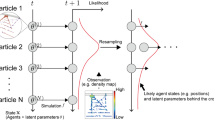Abstract
Crowd movement analysis methods structurally suffer from the problems of scalability and lack of empirical data. Macro scale approaches can tackle larger crowds, but they prevent direct representation of dynamics occurring on the micro scale which may be more easily related to observations.
In this work, we present and experiment a hierarchical approach which aims at conciliating the contrast through the combination of fine grained simulation and coarse grained analytical techniques. To this end, agent based simulation is applied on micro scale patches where mechanisms resembling reality can be more easily reproduced. Measurements on simulation results are then used as parameters for an analytical model which exploits mean field techniques to efficiently approximate the emerging crowd behavior through the fluid limit obtained when the crowd density tends to infinity.
The approach is experimented with reference to a crowd evacuation scenario, using NetLogo as engine for spatial agent based simulation and JSam framework as a solution engine for mean field analysis.
Access this chapter
Tax calculation will be finalised at checkout
Purchases are for personal use only
Similar content being viewed by others
References
Massink, M., Latella, D., Bracciali, A., Harrison, M.D.: A scalable fluid flow process algebraic approach to emergency egress analysis. In: 8th IEEE International Conference on Software Engineering and Formal Methods (SEFM), pp. 169–180. IEEE (2010)
von Sivers, I., Templeton, A., Köster, G., Drury, J., Philippides, A.: Humans do not always act selfishly: social identity and helping in emergency evacuation simulation. Transp. Res. Procedia 2, 585–593 (2014)
Helbing, D., Farkas, I., Vicsek, T.: Simulating dynamical features of escape panic. Nature 407(6803), 487–490 (2000)
Gorrini, A., Bandini, S., Vizzari, G.: Empirical investigation on pedestrian crowd dynamics and grouping. In: Chraibi, M., Boltes, M., Schadschneider, A., Seyfried, A. (eds.) Traffic and Granular Flow ’13, pp. 83–91. Springer, Heidelberg (2015)
Khan, S.D., Vizzari, G., Bandini, S.: Identifying sources and sinks and detecting dominant motion patterns in crowds. Transp. Res. Procedia 2, 195–200 (2014)
Helbing, D., Johansson, A., Al-Abideen, H.Z.: Dynamics of crowd disasters: an empirical study. Phys. Rev. E 75(4), 046109 (2007)
Narain, R., Golas, A., Curtis, S., Lin, M.C.: Aggregate dynamics for dense crowd simulation. ACM Trans. Graph. (TOG) 28, 122 (2009). ACM
Dogbe, C.: On the modelling of crowd dynamics by generalized kinetic models. J. Math. Anal. Appl. 387(2), 512–532 (2012)
Templeton, A., Drury, J., Philippides, A.: From mindless masses to small groups: conceptualizing collective behavior in crowd modeling. Rev. Gen. Psychol. 19(3), 215–229 (2015)
Wijermans, N., Jorna, R., Jager, W., van Vliet, T., Adang, O.: Cross: modelling crowd behaviour with social-cognitive agents. J. Artif. Soc. Soc. Simul. 16(4), 1 (2013)
Bagnoli, F., Rechtman, R.: Bifurcations in models of a society of reasonable contrarians and conformists. Phys. Rev. E 92(4), 042913 (2015)
Le Boudec, J-Y., McDonald, D., Mundinger, J.: A generic mean field convergence result for systems of interacting objects. In: Fourth International Conference on the Quantitative Evaluation of Systems, QEST 2007, pp. 3–18. IEEE (2007)
Latella, D., Loreti, M., Massink, M.: On-the-fly PCTL fast mean-field approximated model-checking for self-organising coordination. Sci. Comput. Program. 110, 23–50 (2015)
Moussaïd, M., Helbing, D., Theraulaz, G.: How simple rules determine pedestrian behavior and crowd disasters. Proc. Nat. Acad. Sci. 108(17), 6884–6888 (2011)
Author information
Authors and Affiliations
Corresponding author
Editor information
Editors and Affiliations
Rights and permissions
Copyright information
© 2016 Springer International Publishing AG
About this paper
Cite this paper
Mehic, S., Tadano, K., Vicario, E. (2016). Combining Simulation and Mean Field Analysis in Quantitative Evaluation of Crowd Evacuation Scenarios. In: Fiems, D., Paolieri, M., Platis, A. (eds) Computer Performance Engineering. EPEW 2016. Lecture Notes in Computer Science(), vol 9951. Springer, Cham. https://doi.org/10.1007/978-3-319-46433-6_12
Download citation
DOI: https://doi.org/10.1007/978-3-319-46433-6_12
Published:
Publisher Name: Springer, Cham
Print ISBN: 978-3-319-46432-9
Online ISBN: 978-3-319-46433-6
eBook Packages: Computer ScienceComputer Science (R0)




